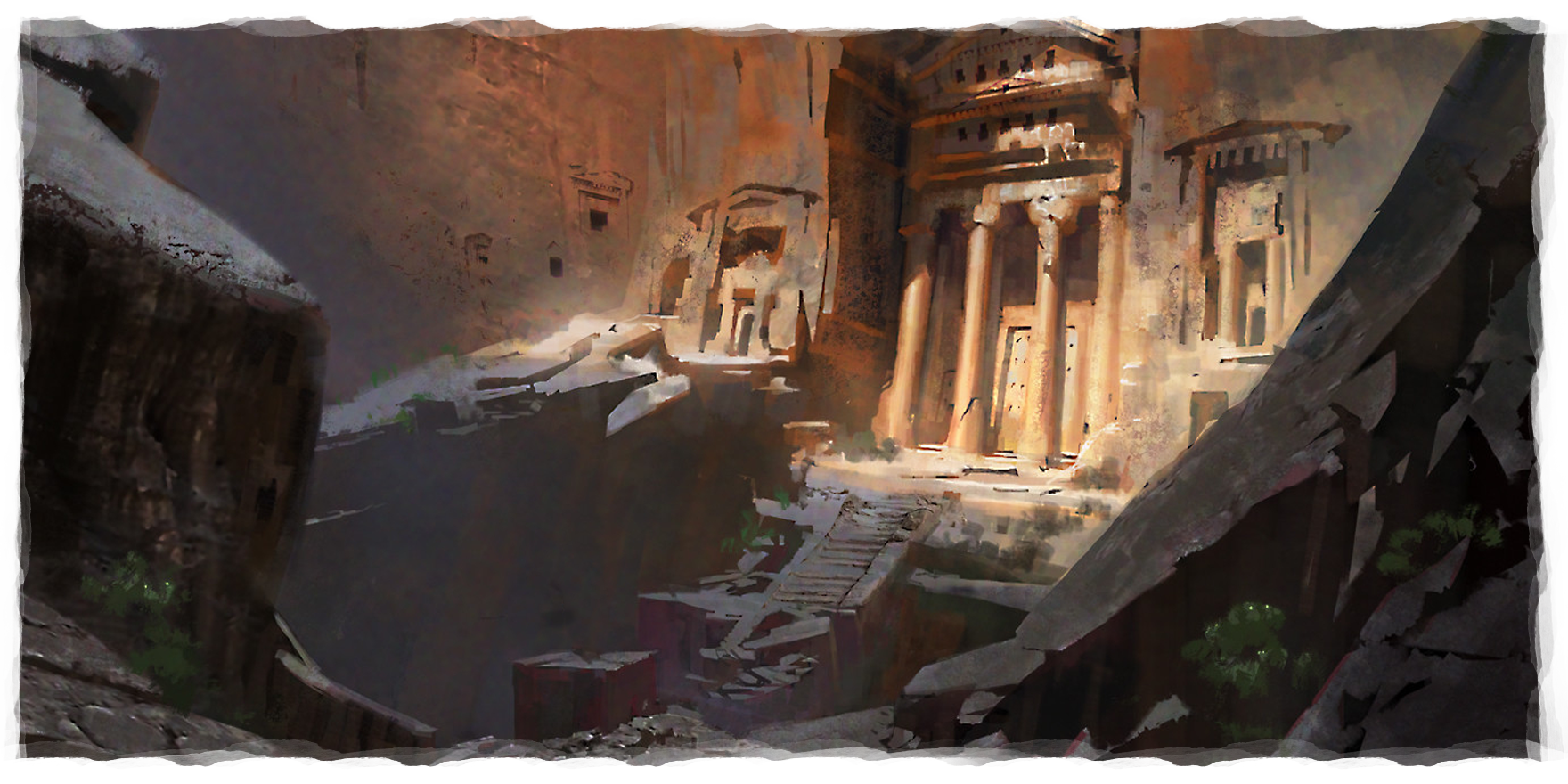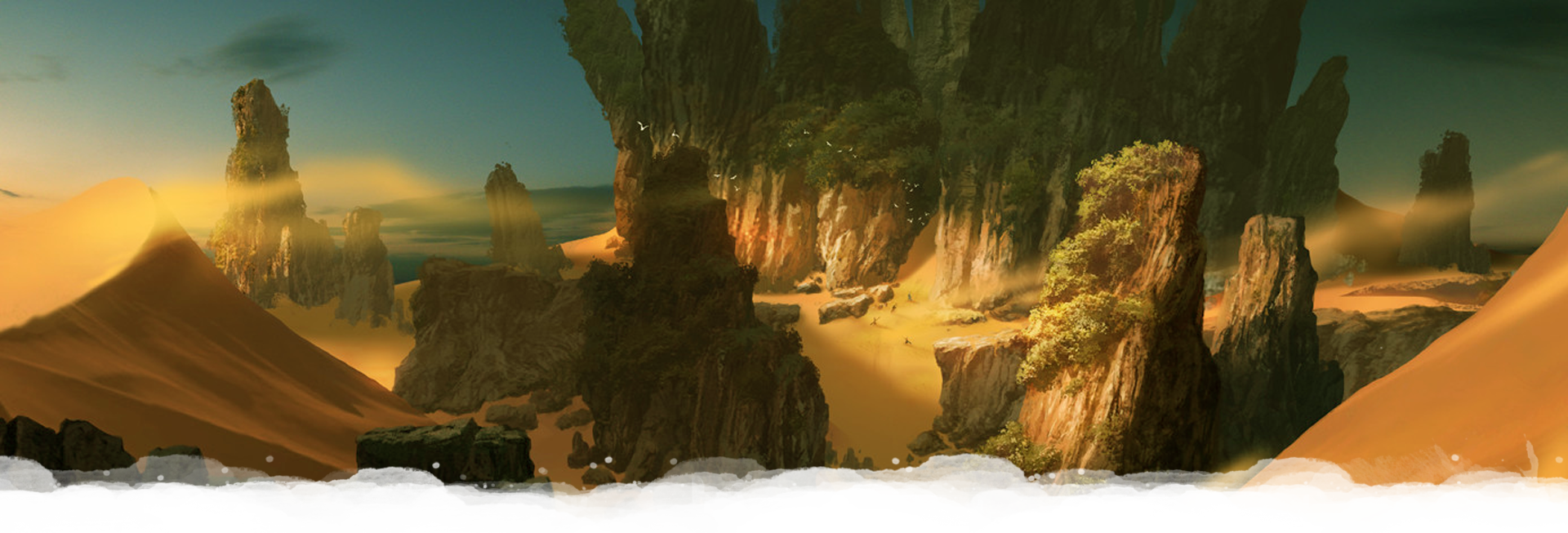Bonewall Mountains
Rising like the jagged teeth of an ancient beast, the Bonewall Mountains form the natural westernmost boundary of Nioba, standing as a final defense against the creeping sands of the Sulfur Sea. Towering peaks of dark, craggy stone loom over the land, their sheer cliffs and labyrinthine ravines carved by time and erosion. Unlike the desolation beyond them, the Bonewall is a place of stability and resilience, where the land still clings to life despite the ever-present threat of Hephsut’s dominion.
For centuries, these mountains have served as both a refuge and a battleground. In ages past, the Prophet-Kings built sacred tombs within its cliffs, believing that the heights brought them closer to Amnut, its peaks a place where the great rulers of Nioba were laid to rest so that their wisdom might watch over the land for eternity. The mountains also sheltered exiles, outcasts, and those who sought to escape the wars of Nioba’s past, their caverns and hidden passes offering sanctuary to those who could endure their harsh climate.
But time has changed the Bonewall. Though it still stands, the Prophet-Kings are long gone, and their tombs—once places of pilgrimage—now serve as the final hiding places of those who refuse to kneel to Hephsut’s rule. In the deep caves and hidden valleys, small clans of sun-worshippers endure, their traditions preserved in secrecy. Led by the last descendants of the Sun Ward, these scattered groups have survived in exile for generations, their numbers few but their faith unshaken.
Yet, despite the Bonewall’s imposing defenses, it is no longer an unbroken wall against the encroaching darkness. Hephsut’s forces have already breached their sacred grounds, defiling the Valley of the Prophet-Kings, where his undead legions now patrol the tombs. For now, the Bonewall remains unconquered, but for how long, none can say.
The tombs were built into the cliffs of a great valley—a passage through the mountains, carved from the living rock, their entrances marked by towering pillars and reliefs of golden suns. Each king, each oracle, each high priest was seated upright upon a stone throne, their bodies preserved with sacred oils and wrapped in enchanted cloth, forever gazing towards the west where the sun sets.
But there are no kings here now. Their faces have been shattered, their thrones toppled, their names scratched from history. Where once the living came to seek wisdom, now only the dead answer—and they do not speak with kindness.
Geography & Features
The Bonewall Mountains stretch in a great, natural arc along Nioba’s north-western border, separating its fertile river valleys from the suffocating wasteland of the Sulfur Sea. The mountains are steep, jagged, and perilous, with sheer cliffs, deep ravines, and treacherous switchback trails that make passage through them an ordeal even for experienced travelers. The highest peaks scrape the sky, their summits crowned in thin veils of mist, while the lower slopes are carved by seasonal river valleys, hidden grottoes, and twisting canyons where ancient ruins lie buried. Among these ruins are the tombs of the Prophet-Kings, long abandoned after being desecrated by Hephsut’s forces centuries ago, their sacred halls occasionally turned into recruiting grounds for Hephsut's most elite Risen. The mountains also contain underground tunnels and vast caverns, some natural and others carved by forgotten hands. These hidden pathways have long served as smugglers’ routes, escape tunnels, and secret lairs for gurella fighters, their entrances known only to those who have called the Bonewall home for generations. But deep within the rock, beyond the reach of sunlight, there are darker things that stir—ancient remnants of the Nidean age, buried secrets that even Hephsut’s necromancers have yet to unearth.The Valley of the Prophet-Kings
Before Hephsut’s dominion, before even the rise of Kitesh, the Prophet-Kings of Nioba looked to the heavens for guidance. It was said that those who climbed high enough, where the wind grew thin and the stars burned brighter, could hear the whispers of Amnut, the god of the sun. These peaks were more than just burial grounds; they were gateways to eternity, places where the souls of kings could still watch over their people.
Risen Sentinels
The Bonewall does not stand empty. Along its narrowest passes, where the trails still wind through the cliffs, stand Hephsut’s sentinels—undying warriors bound to eternal vigilance. They were not born of the Scarab Scourge, nor were they raised as common thralls. These were once Nioba’s greatest champions, men who fought against Hephsut in his first war. In death, they are his most loyal guards. They do not pursue. They do not hunt. They merely wait, still clad in the armor of ages past, their rusted blades clutched in skeletal hands. Their eyes burn with cold green Fire, their lips frozen in expressions of rage, grief, or silent duty. To some, they are an eerie remnant of what Nioba once was, a reflection of its long-lost honor. To others, they are nothing more than puppets, shackled to the will of a tyrant who refuses to let the past die. No one crosses the Bonewall’s ancient roads without facing them.Hidden Sun Clans
Scattered among the Bonewall’s ravines and caverns, hidden from the gaze of Hephsut’s ever-watchful Risen, the Sun Clans live in quiet exile. They do not fight. They do not seek war. They survive. These small, insular groups are the descendants of priests, scholars, and warriors who fled into the mountains when Nioba fell, their ancestors carrying with them the last fragments of faith in the Sun Father. Each clan is led by a hereditary Sun-Warden, though the title has long since lost its meaning. No armies remain for them to command, no temples for them to guard. Their duty now is one of remembrance—to preserve what little remains of Kitesh’s teachings, to pass down the old rites in whispered prayers, and to ensure that the name of the Sun is not lost entirely. They live in seclusion, tending to hidden springs, growing what little food the mountains allow, and moving often to avoid the patrols of the dead. They do not dream of reclaiming Nioba, nor do they believe salvation is near. But they remember, and in their remembering, they endure. They wait. Not for war, not for conquest, but for the day—if it ever comes—when the Sun may rise again.
Climate & Environment
The Bonewall Mountains experience extreme shifts in climate, depending on their elevation and proximity to the Sulfur Sea.- South-Eastern Slopes. The Nioban side of the mountains is dry and arid, but not lifeless. Hardy shrubs, cacti, and desert trees cling to the slopes, drawing moisture from underground springs that trickle through the rock. Small rivers and waterfalls dot the landscape, their waters flowing eastward toward the River Niobe, sustaining scattered villages and agricultural outposts.
- North-Western Slopes. On the north-western side, the Air is toxic, laced with sulfuric fumes that creep up the mountains from the wasteland below. The rock is blackened and brittle, stained from centuries of exposure to the noxious mists. Few creatures can survive here, and those that do are either twisted by the corruption of the Sulfur Sea or possess unnatural resilience.
- The High Peaks. Above both regions, the highest summits are cold, wind-blasted, and unyielding, their thin air making them nearly uninhabitable. Even Hephsut’s undead rarely patrol these heights, leaving them as one of the last untouched places in Nioba.
Type
Mountain Range
Location under
Included Organizations
Owner/Ruler
Owning Organization



Comments